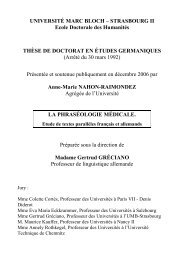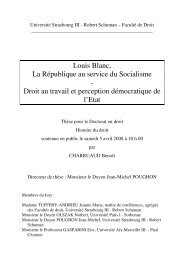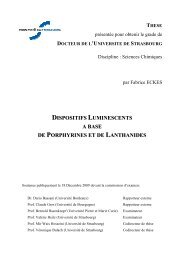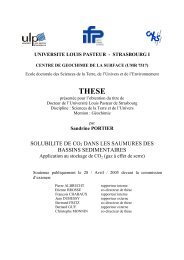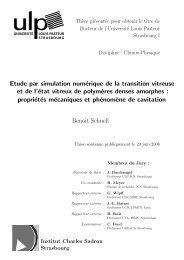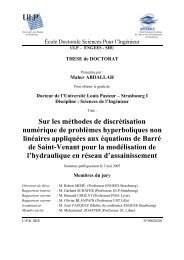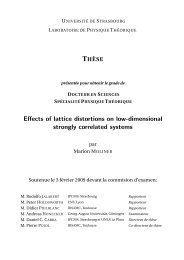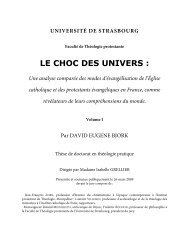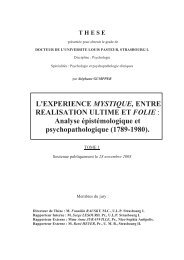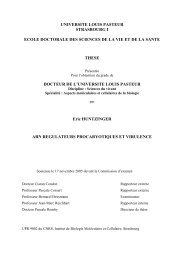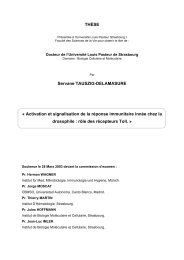Anthony KERMAGORET - THESES ET MEMOIRES DE L'UDS
Anthony KERMAGORET - THESES ET MEMOIRES DE L'UDS
Anthony KERMAGORET - THESES ET MEMOIRES DE L'UDS
Create successful ePaper yourself
Turn your PDF publications into a flip-book with our unique Google optimized e-Paper software.
4. Conclusion<br />
Chapitre II<br />
The reaction of NiCl2 with 2 mol. equiv. of the oxazoline alcohol 13 or of (pyridin-2-<br />
yl)methanol led to the formation of the corresponding complexes 14 or 15 in high yield.<br />
Single-crystal X-ray diffraction studies showed that 14 and 15 have dinuclear structures with<br />
octahedral metal coordination, very similar to those of the dinuclear complexes 11 and 12<br />
with oxazoline alcohol or pyridine alcohol ligands bearing gem-dimethyl substituents in α<br />
position to the donor oxygen atom. 54 The reaction of NiCl2 with 3 mol. equiv. of (pyridin-2-<br />
yl)methanol led to the octahedral, mononuclear complex 17 which can also be formed by<br />
reaction of 15 with the pyridine alcohol in a 1:2 ratio. Deprotonation of one of the two<br />
pyridine alcohol ligands of 15 with NaH afforded complex 20.<br />
The complexes 14, 15 and 20 have been evaluated in the catalytic oligomerization of<br />
ethylene with 50, 100 and 200 equiv of MAO or with 2, 4 and 6 equiv of AlEtCl2 as<br />
cocatalyst. When 1.05×10 -2 mmol of complex was used, 15 presented the best activities, up to<br />
187500 mol C2H4/(mol Ni·h) with only 6 equiv of AlEtCl2 and the best selectivities for C4<br />
olefins (up to 97%) and for 1-butene (up to 79%). Under these conditions, 14 and 15 showed<br />
activities and selectivities with AlEtCl2 similar to those of complexes 11 or 12 but, in contrast<br />
to previous observations made with related complexes, the pyridine alcohol ligands led here<br />
to more active complexes than the oxazoline alcohol ligands. 54 This emphasises the difficulty<br />
in generalising the observations made with one system. When 4×10 -2 mmol of precatalysts<br />
was used in the presence of AlEtCl2, 15 and 20 showed similar activities compared to those<br />
obtained with Ni(II) complexes bearing P,N type ligands. 13<br />
With MAO, precatalysts 14, 15 and 20 were very active and 15 presented the highest<br />
activities up to 37100 mol C2H4/(mol Ni·h) with 200 equiv of MAO and selectivities for C4<br />
olefins (up to 94%) and 1-butene (up to 64%) with 50 equiv. of MAO. Precatalysts 14, 15<br />
and 20 in the presence of MAO showed higher activities than 11 and 12 (with 1.05×10 -2<br />
mmol of complex) and Ni(II) complexes bearing P,N type ligands (with 4×10 —2 mmol of<br />
complex). The increase of the ethylene pressure to 30 bar resulted in more active complexes<br />
14 and 15 (the TOF of 15 increased 104300 mol C2H4/(mol Ni·h)) and more selective for C4<br />
olefins (selectivity increase for 14 from 75% to 92%) and for 1-butene (selectivity increase<br />
for 14 from 35% to 61%). In view of the considerable importance of the nature and bonding<br />
mode of the chelating ligands on the catalytic properties of the metal complexes, further<br />
studies are required to improve these catalytic systems.<br />
19



